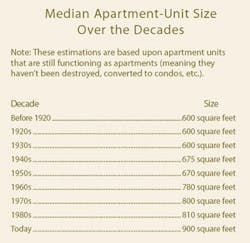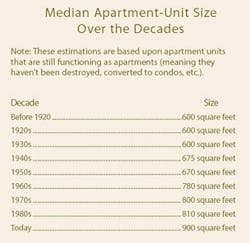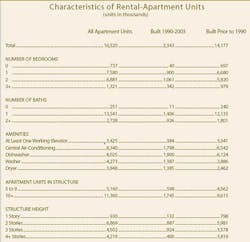The Ever-Evolving Apartment
In the manner of today’s “bigger-is-better” society, U.S. apartments have steadily grown larger and offered more luxury to residents, especially since the 1960s.
According to the Washington, D.C.- based National Multi Housing Council’s (NMHC’s) 2003 American Housing Survey, rental units built prior to 1920 had a median size of approximately 600 square feet. Today, the median figure tops 900 square feet. The average size of a rental unit built in 1999 was 1,105 square feet, up from 922 square feet in 1985. That’s the highest reading since the U.S. Census Bureau began collecting this information in the 1970s.
Simply put, rental housing isn’t a dying breed in a landscape dotted with single-family homes. Statistics from the NMHC’s 2005 annual report show that nearly one-third of Americans rent. Rental revenue from apartments (buildings with five or more rental units) totals more than $117 billion annually; managing and operating apartments sustains approximately 500,000 jobs.
Over the years, the multi-family industry has weathered a number of changes beyond increasing unit size, including changing renter demographics and evolving technology. These changes have consequently shaped the property manager’s role from a building superintendent who fixes leaky faucets to an individual who oversees a dynamic rental community and a diverse property management team.
Changing Demographics
One hundred years ago, apartment buildings were small, usually having no more than 35 to 40 units. The 1960s ushered in big changes with the advent of garden-apartment complexes - multiple large buildings with 200 to 250 total units that surround a pool and a clubhouse with a fitness room. This began the rise of amenities in the multi-family sector.
Today’s savvy consumers want comfort and luxury. While the aging metropolitan fourth-floor walk-up Pullman flat exudes vintage charm and hard-to-replicate architectural detailing, today’s multi-family housing options have taken the basic rental unit and turned it into a home, offering such things as kitchens with islands, high-speed Internet access, direct garage access, soaking tubs in master bathrooms, and high-end finishes.
A new breed of multi-family dwellers is shaping these changes. “We have seen a dramatic demographic shift in the last 10 years,” says Mark Humphreys, president and founder at Humphreys & Partners Architects LP, a Dallas-based firm known for its multi-family housing work. “There’s been a paradigm shift from thinking that apartments are for people just getting out of college to the fact that Baby Boomers are becoming empty nesters looking to downsize from a 3,000-square-foot, single-family home to a townhouse, condominium, or even an apartment (if it is not a throwback to what they lived in after college).”
Construction of apartment communities in the last 5 years has added an average of 220,000 new apartment homes per year, while the value of the new construction has averaged more than $25 billion annually, as reported in the NMHC’s 2005 annual report.
Some of this growth comes courtesy of the burgeoning population of empty nesters looking to downsize. With this population also comes the demand for single-family essence in multi-family design. Empty nesters want to downsize, but they also want to maintain their standards of living.
“Apartment owners must adapt to new marketing techniques and services to attract and retain a diverse population,” notes Jeanne McGlynn Delgado, NMHC’s vice president of property management.
One such marketing technique comes in the form of design. New design erases the stalwart garden-apartment format, eschewing breezeways, parking lots, or balconies on the façade for a structure that more closely resembles a single-family residence.
For the past 10 years, Humphreys has finely honed a concept he calls the “Big House®,” a multi-family building that looks strikingly like a single-family mansion (but houses 10 separate multi-family units). He has designed the Big House concept for both apartment communities and condominium developments.
“It helps us get approval from cities opposed to multi-family construction,” he says. “If you’re doing something that looks like a nice, single-family home, it’s much easier to get approved than an ugly, 3-story apartment project.”
Technology Shifts
Changing technology also drives consumer demand in the multi-family market. “The demand for wireless capabilities and cyber cafés will continue to grow as work schedules facilitate more telecommuting from home,” Delgado says.
David Cardwell, NMHC’s vice president of capital markets and technology, says the move to provide building-wide Internet communications - either wired or wireless - follows on the heels of the cable industry’s initiative to bring cable television to multi-family housing communities in the 1980s and 1990s. Cable became a must; high-speed Internet now falls into that same category, Cardwell says.
“If I were evaluating a property in 1997, I probably would not consider [whether] the apartment had broadband, digital-video capabilities, and other communications [services] for the residents. If it didn’t have cable, I might have asked a question. If it didn’t have high-speed Internet, I didn’t care,” he says. “Today, I do care. High-speed Internet capabilities in a property must exist. Today’s investors and owners need to make sure they have the proper infrastructure in place. Apartment properties are much more virtual 24/7 today than even just a few years ago.”
SOURCE: NMHC TABULATIONS OF THE U.S. CENSUS BUREAU’S 2003 AMERICAN HOUSING SURVEY WITH CORRECTED SAMPLE WEIGHTS. DUE TO ROUNDING AND MISSING DATA FOR SOME VARIABLES, FIGURES DO NOT ALWAYS TOTAL.
Robin Suttell ([email protected]), based in Cleveland, is contributing editor at Buildings magazine.


